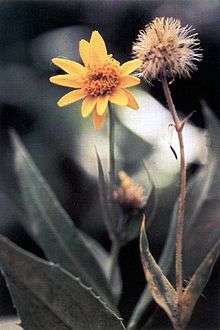Arnica lanceolata
| Arnica lanceolata | |
|---|---|
 | |
| A. lanceolata subsp. prima California | |
| Scientific classification | |
| Kingdom: | Plantae |
| (unranked): | Angiosperms |
| (unranked): | Eudicots |
| (unranked): | Asterids |
| Order: | Asterales |
| Family: | Asteraceae |
| Tribe: | Heliantheae |
| Genus: | Arnica |
| Species: | A. lanceolata |
| Binomial name | |
| Arnica lanceolata | |
| Synonyms[1][2] | |
| |
Arnica lanceolata is a North American species of arnica in the sunflower family, known by the common name clasping arnica[2] or lanceleaf arnica.[3] It has a disjunct (discontinuous) distribution in western North America and northeastern North America.[4][5]
Arnica lanceolata is a perennial herb usually growing from a small rhizome and producing one or more hairy, glandular stems. The stems are lined with 5 to 10 pairs of oval-shaped, toothed leaves up to 12 centimeters long. The inflorescence is a cluster of several daisy-like flower heads with a center of brownish disc florets and a fringe of yellow ray florets 1 to 2 centimeters long. The fruit is a cylindrical achene covered in hairs and with a light brown pappus at one end.[2]
- Arnica lanceolata subsp. lanceolata - Quebec, New Brunswick, Maine, New Hampshire, Vermont, New York
- Arnica lanceolata subsp. prima (Maguire) Strother & S.J.Wolf - Alaska, Yukon, Northwest Territories, Alberta, British Columbia, Washington, Oregon, California, Idaho, Montana, Utah, Wyoming, Nevada
References
- 1 2 The Plant List Arnica lanceolata Nutt.
- 1 2 3 4 Flora of North America, Clasping arnica, Arnica lanceolata
- ↑ "Arnica lanceolata". Natural Resources Conservation Service PLANTS Database. USDA. Retrieved 26 May 2015.
- ↑ Biota of North America Program 2014 state-level distribution map
- ↑ Calflora taxon report, University of California, Arnica lanceolata Nutt. ssp. prima (Maguire) Strother & S.J. Wolf Clasping arnica
External links
- Go Botany, New England Wildflower Society
- Maine Department of Agriculture, Conservation and Forestry, Maine Natural Areas Program, Arnica lanceolata Nutt., Flower of Hairy Arnica description and ecological information with photos
This article is issued from
Wikipedia.
The text is licensed under Creative Commons - Attribution - Sharealike.
Additional terms may apply for the media files.